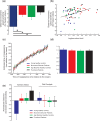Linking differences in action perception with differences in action execution
- PMID: 25691777
- PMCID: PMC4526482
- DOI: 10.1093/scan/nsu161
Linking differences in action perception with differences in action execution
Abstract
Successful human social interactions depend upon the transmission of verbal and non-verbal signals from one individual to another. Non-verbal social communication is realized through our ability to read and understand information present in other people's actions. It has been proposed that employing the same motor programs, we use to execute an action when observing the same action underlies this action understanding. The main prediction of this framework is that action perception should be strongly correlated with parameters of action execution. Here, we demonstrate that subjects' sensitivity to observed movement speeds is dependent upon how quickly they themselves executed the observed action. This result is consistent with the motor theory of social cognition and suggests that failures in non-verbal social interactions between individuals may in part result from differences in how those individuals move.
Keywords: action observation; action perception; mirror neurons; movement disorders; perception deficits.
© The Author (2015). Published by Oxford University Press.
Figures


Similar articles
-
The role of motor contagion in the prediction of action.Neuropsychologia. 2005;43(2):260-7. doi: 10.1016/j.neuropsychologia.2004.11.012. Epub 2005 Jan 7. Neuropsychologia. 2005. PMID: 15707910 Review.
-
Verbal social primes alter motor contagion during action observation.Q J Exp Psychol (Hove). 2016;69(6):1041-8. doi: 10.1080/17470218.2015.1113304. Epub 2016 Feb 16. Q J Exp Psychol (Hove). 2016. PMID: 26879285
-
An interference effect of observed biological movement on action.Curr Biol. 2003 Mar 18;13(6):522-5. doi: 10.1016/s0960-9822(03)00165-9. Curr Biol. 2003. PMID: 12646137
-
The performance and observation of action shape future behaviour.Brain Cogn. 2009 Nov;71(2):64-71. doi: 10.1016/j.bandc.2009.04.001. Epub 2009 Apr 29. Brain Cogn. 2009. PMID: 19406547
-
Captured by motion: dance, action understanding, and social cognition.Brain Cogn. 2011 Nov;77(2):231-6. doi: 10.1016/j.bandc.2011.08.005. Epub 2011 Aug 30. Brain Cogn. 2011. PMID: 21880410 Review.
Cited by
-
Motor Recruitment during Action Observation: Effect of Interindividual Differences in Action Strategy.Cereb Cortex. 2020 Jun 1;30(7):3910-3920. doi: 10.1093/cercor/bhaa006. Cereb Cortex. 2020. PMID: 32043124 Free PMC article.
-
What neuromodulation and lesion studies tell us about the function of the mirror neuron system and embodied cognition.Curr Opin Psychol. 2018 Dec;24:35-40. doi: 10.1016/j.copsyc.2018.04.001. Epub 2018 Apr 11. Curr Opin Psychol. 2018. PMID: 29734039 Free PMC article. Review.
-
If You Are Old, Videos Look Slow. The Paradoxical Effect of Age-Related Motor Decline on the Kinematic Interpretation of Visual Scenes.Front Hum Neurosci. 2022 Jan 5;15:783090. doi: 10.3389/fnhum.2021.783090. eCollection 2021. Front Hum Neurosci. 2022. PMID: 35069153 Free PMC article.
-
When action prediction grows old: An fMRI study.Hum Brain Mapp. 2023 Feb 1;44(2):373-387. doi: 10.1002/hbm.26049. Epub 2022 Aug 23. Hum Brain Mapp. 2023. PMID: 35997233 Free PMC article.
-
Your move or mine? Music training and kinematic compatibility modulate synchronization with self- versus other-generated dance movement.Psychol Res. 2020 Feb;84(1):62-80. doi: 10.1007/s00426-018-0987-6. Epub 2018 Jan 29. Psychol Res. 2020. PMID: 29380047
References
-
- Bhatia KP, Bhatt MH, Marsden CD. The causalgia-dystonia syndrome. Brain. 1993;116(Pt 4):843–51. - PubMed
-
- Blaffer-Hrdy S. Mothers and Others: The Evolutionary Origins of Mutual Understanding. Cambridge: Harvard University Press; 2009.
-
- Buxbaum LJ, Kyle KM, Menon R. On beyond mirror neurons: internal representations subserving imitation and recognition of skilled object-related actions in humans. Brain Research Cognitive Brain Research. 2005;25(1):226–39. - PubMed
Publication types
MeSH terms
Grants and funding
LinkOut - more resources
Full Text Sources
Other Literature Sources

